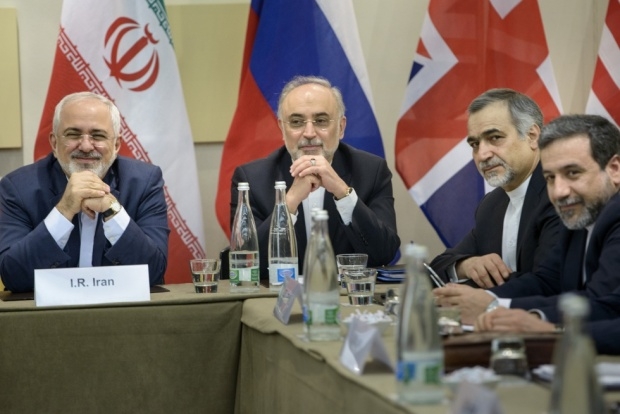'New era' in Iran science with end of sanctions: Report

WASHINGTON - The Iran nuclear deal will usher in a new era in science by lifting sanctions and encouraging research in the Islamic Republic, the US journal Science said Thursday.
Sanctions aimed at preventing Iran from gaining a nuclear weapon in recent years have also banned scientists from importing fossils, downloading software, subscribing to international science journals and buying much-needed equipment from abroad, the magazine reported in a special issue on the topic.
Still, science has managed to thrive in Iran, according to Allan Goodman, president of the Institute of International Education in New York.
"We got a pretty consistent message that their science is alive and well," Goodman, who traveled to Iran earlier this year with a group of US university officials looking for ways to collaborate with Iranian scientists, was quoted as saying.
The assassination of five Iranian nuclear scientists over the past decade did not deter the country from pursuing what it has described as a peaceful programme aimed at energy production, according to Ali Akbar Salehi, president of the Atomic Energy Organisation of Iran.
"This did not really turn into an impediment to our nuclear activities," he told the journal Science.
"In fact it gave an impetus to the field, in the sense that after [the assassinations], many students who were studying in other fields changed to nuclear science."
In other areas too, such as when Iranian scientists were barred from importing seismic sensors to detect earthquakes, innovators devised their own, the report said.
Iran's Minister of Science, Research and Technology, Mohammad Farhadi, said in an accompanying essay that sanctions "pushed its science, industry, and service sectors to cooperate in new and fruitful ways and also forced scientists to work more creatively and promote a knowledge-based economy for the first time in Iran's history".
Now, the Islamic Republic is looking forward to more international partnerships and research, he said.
"We invite scientists from all over the world to initiate a collaborative programme with our scientists. Iran is ready."
Relief from economic sanctions is expected by year's end.
Astronomy, synchotron
Plans to build a world-class astronomy observatory have pressed on, and the next year construction is set to begin on the $30mn Iranian National Observatory (INO), a 3.4-metre optical telescope that will study exoplanets and gamma ray bursts, hunt for dark matter and probe galaxy formation.
Piero Salinari of the Arcetri Astrophysical Observatory in Florence, Italy said that when completed in four or five years, it could be the best general-purpose telescope in the region.
Another big project is the construction, set to begin in 2018, of "Iran's first synchrotron, a source of brilliant x-ray light for studies of everything from biological molecules to advanced materials," said the report.
"The $300mn Iranian Light Source Facility (ILSF) is the country's biggest basic science project ever - and expectations are high inside and outside the Islamic Republic."
David Attwood, an applied physicist at the University of California, Berkeley, who visited the ILSF's office in Tehran last year, said the synchrotron "will offer Iran the potential to do world-class science."
Iran has also forged ahead in stem cell research, thanks to a 2002 fatwa from Iran's supreme leader declaring such research permissible under Islamic Law, though reproductive cloning in humans remains out of bounds, the journal reported.
"Surprisingly, Iran has some of the most liberal laws on stem cell research in the world," said Ali Brivanlou, the Iranian-born head of the laboratory of molecular embryology at The Rockefeller University in New York City.
The Royan Institute in Tehran, founded to help infertile Iranians, "has since become a heavyweight in stem cell research, publishing hundreds of papers and scoring successes in animal cloning despite Iran's isolation," the journal said.
'New era'
As part of the nuclear agreement, the Fordow uranium enrichment facility will be converted into an international research centre where experts will work on projects involving fusion, astrophysics and radiomedicine.
Government spending on science in Iran is far less than what the United States spends - about $30bn annually through the US National Institutes of Health.
The Iranian government's budget target for science spending is three percent of gross domestic product, but "the reality is closer to 0.5 percent, which in 2014 amounted to $1.75bn," according to Vahid Ahmadi, Iran's deputy science minister.
Ahmadi nevertheless expressed hope for the future.
"It's a new era for science in Iran," Ahmadi said.
"We're entering the post-sanctions era."
Middle East Eye propose une couverture et une analyse indépendantes et incomparables du Moyen-Orient, de l’Afrique du Nord et d’autres régions du monde. Pour en savoir plus sur la reprise de ce contenu et les frais qui s’appliquent, veuillez remplir ce formulaire [en anglais]. Pour en savoir plus sur MEE, cliquez ici [en anglais].




